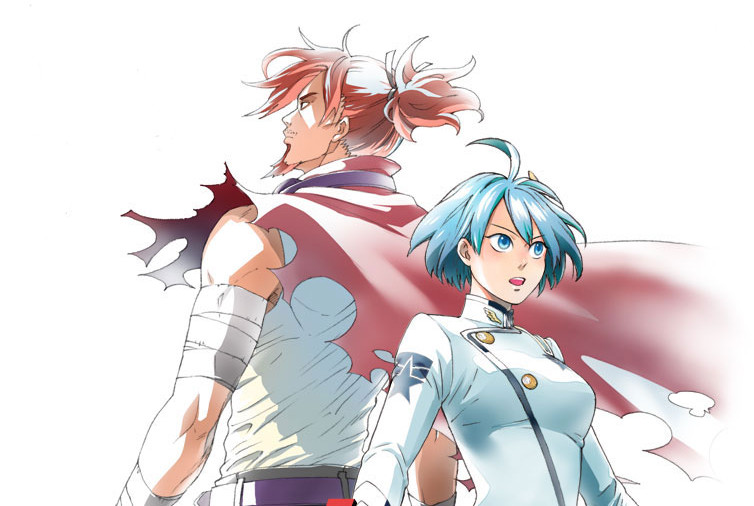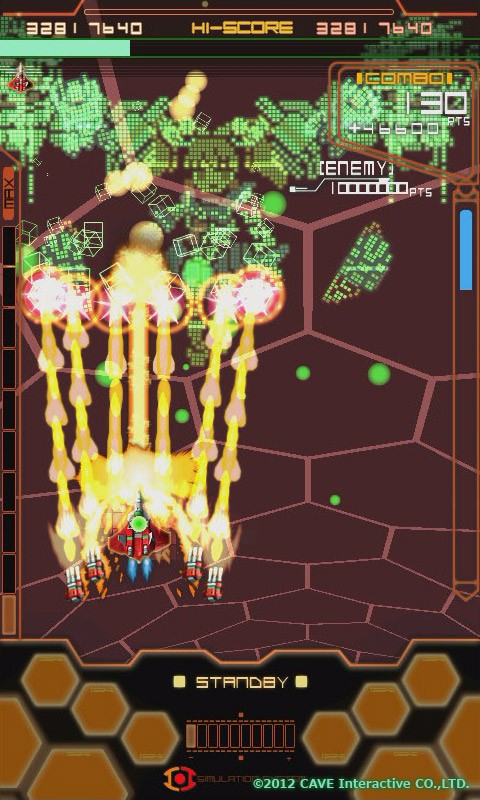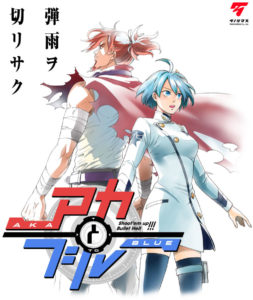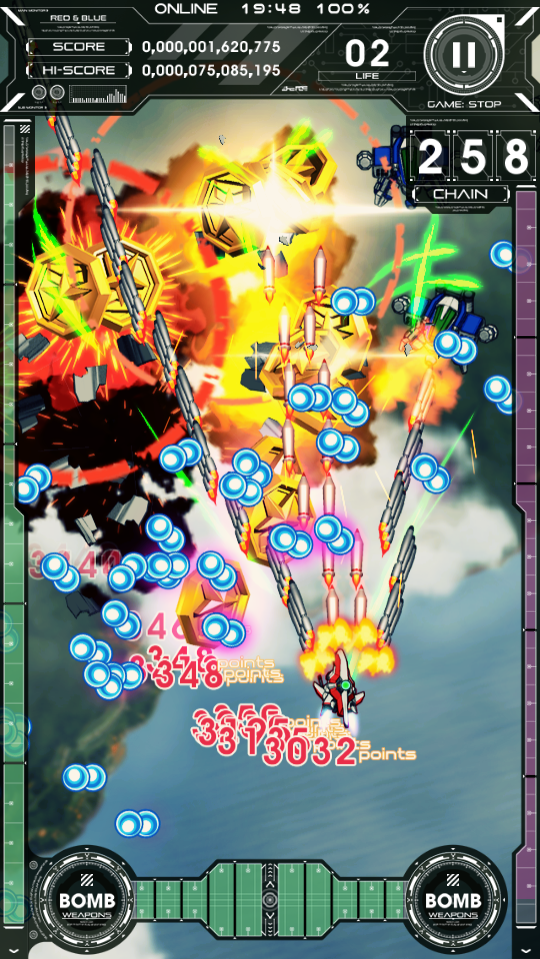The landscape of Japanese gaming has changed tremendously over the past decade, and perhaps the most seismic shift is the explosive popularity of mobile gaming on smartphones. The accessibility, low cost, and ease of development for iOS and Android systems combined with the tremendous installed user base has created a brand new market for niche genres and retro-styled games. Shooting games in particular have encountered something of a resurgence on these platforms: Recently, CAVE’s Gothic wa Mahou Otome, a free-to-play shooter with touchscreen-based movement, has become the company’s biggest hit in years.
But Cave’s not the only face in the mobile STG scene. Recently, a new company called Tanoshimasu unveiled Aka to Blue, a mobile-based STG with a style akin to many of the late 90s-early 00s danmaku classics that established the bullet hell subgenre. It wasn’t terribly surprising to learn that the head of Tanoshimasu, Hiroyuki Kimura, was himself a former employee of CAVE.
Being a longtime CAVE fan, I’m pretty excited for this game, and I feel like it’s also the sort of game that would benefit greatly from more exposure and word-of-mouth. I reached out to Hiroyuki Kimura via a mutual contact and asked him if he’d like to talk a bit about his industry experience, the formation of Tanoshimasu, and the current state of Aka and Blue’s development. Read on!
Hello, Kimura-san! Thank you for taking the time to talk to gaming.moe. Could you please tell me a little bit about yourselves and what you do at Tanoshimasu?
No, if anything thank you for giving Tanoshimasu an opportunity like this! I’m excited to respond to the questions you’ve sent over. First, let me introduce myself. My name is Hiroyuki Kimura and I’m the CEO of Tanoshimasu Co., Ltd. I’ve been working in the game industry for 10 years at this point, and at points worked at a company Climax, where I worked on among other things games like Shining Force and Landstalker, and CAVE, who are famous for their shooters. I’ve also worked at Bandai Namco’s studio for a little bit, as well as a few other companies.
Our company, Tanoshimasu, was founded in April 2015. It’s a small operation consisting only of myself, serving as both game planner and graphic designer, and two programmers. We don’t sub-contract game development, and only work on original titles from development to release.
How did you get into the game industry?
My childhood was right at the dawn of the Famicom era, meaning that I had a lot of opportunities to play Super Mario Bros., Dragon Quest, Final Fantasy, Street Fighter and more. I entered the game industry with the ambition of creating my own game. That said, I wasn’t skilled as a programmer or designer, so it was actually tough to get my foot in the door… In school, I studied programming in a course once, but I found it too difficult and ultimately gave up. In that sense, it’s surprising how far I’ve gotten simply by way of zeal and enthusiasm.
What drew you to work at Cave? Can you tell us a bit about the games you worked on while you were there?
My motivation for joining CAVE was that I knew it as a company game that only makes shooting games, but I felt like you really should be able to make all kinds of games there. Saying this might surprise people but before I entered CAVE, I hadn’t played many danmaku shooters and while I knew that CAVE was famous for its shooting games, I wasn’t knowledgeable about what kind of games they were actually making. I should note that before I entered CAVE, I had only developed roleplaying and action game titles, and had not worked on a shooter previously. Really, my boss at the time probably saw that aspect of me as a positive, which resulted in me joining CAVE. I think he wanted to create games other than shooters, and thus wanted to bring people with experience beyond that genre onto the team, and that was just what I had. Having said that, the department that I was hired into was still mostly focused on shooters, and after I was hired, I was involved almost entirely with shooting game development. I worked mainly on three shooter titles for CAVE. The first one was Akai Katana Shin for Xbox360, but actually the part of that game that I was focused on wasn’t the shooting/scoring portion of the game, but instead the user interface. If you play the game you’ll know what I mean, but that game’s user interface is different from any other CAVE title.
We built it seamlessly so that the screen wouldn’t black-out when going from menu to menu. Additionally, we made little improvements around the game like changing the colors around the screen in real-time to make it easier for players to understand which screen they were on. The next game I was involved with was the arcade version of Dodonpachi Saidaioujou. For this game, I was less involved with the shooting game portion and focused more on how enemies appeared on-screen, how voice samples were triggered, and creating bosses that brought to mind the older Dodonpachi games. We really put in a lot of effort around the voice in that title. In danmaku shooters, the harder they get, the more focused you on are avoiding bullets, which leads you to focus only on your ship. There’s not much room in your head left to look at the boss’ remaining life, so we wanted to let the player focus on their ship and use their ears to pick up updates on how they were doing via voice samples. For some of the boss animations as well we added animations that were homages to Dodonpachi Daioujou, in order to emphasize that this was a game in the Dodonpachi lineage, and in terms of the on-screen characters, we wanted to have them support and encourage players by bringing their image outside of the ship itself and onto the screen and into the audio.
The last game that I was involved with at CAVE was “DODONPACHI MAXIMUM”. At the time, CAVE was still not very well known overseas, so we wanted to create a “catalog-oriented” title because we thought it could make international players more aware of CAVE IPs. Since this was CAVE’s first original smartphone title, we had a lot of headaches around mobile hardware specs — at the time, they were much lower than they are today, and since the hardware we were developing for did not support 60 FPS gameplay, we had a lot of trouble doing what we wanted to do. Like the other games I was involved in, I didn’t work on the scoring system and instead focused on planning the controls. At the time, shooting games by other developers all had touchable “buttons” positioned around the screen. Danmaku shooters summon tons of bullets on-screen, so of course we figured that you would want to concentrate on dodging and that on-screen buttons would be a distraction. Given that, we decided to create a control scheme where you wouldn’t have to press buttons to trigger shots and bombs, which was in that way our own proposal for a simpler control format oriented towards the smartphone shooting game genre. So that’s everything in terms of what I was involved with at CAVE. You may have imagined that I was more involved in the scoring/shooter sections of the games, but that actually isn’t the case. CAVE has always had incredible developers that work on their shooting games, so there wasn’t much point in me opening my mouth around the scoring. I focused on supporting the team from a different perspective.
Why did you leave Cave? What spurred the formation of Tanoshimasu?
I left CAVE for a simple reason: I was ready to get out of the game industry. I had worked in the industry for years, but the pace is brutal, and there were many points where I fell into ill health. I decided I wanted to get married for heath and economic security. While it depends on the company, so I can’t speak for all of them — the reality is that salaries in the Japanese game industry are not as high as you think, and benefits aren’t very good. Until that point, I was able to do what I wanted to do for myself, so I was able to deal with low wages. However, I wanted to focus on providing for my family instead of just my own goals, and decided to aim for work where the benefits would be more stable.
So, I told my wife that I was going to retire from game development. However, her reaction surprised me. She said: “you’ve spent so many years giving so much for other people, but I’d rather see you create your own company so that you can focus on what you want to do. I married you because I liked how much you enjoyed developing games, and I don’t want you to see you quit.” Those words changed my mind, and I decided that I wanted to teach younger game developers about how fun developing games can be, and created Tanoshimasu.
How did you come to choose Tanoshimasu as a name for your team?
Tanoshimasu means “Let them have fun” in Japanese. I chose this name because I wanted to focus on bringing enjoyment to people with the games that we create.
Can you tell me a little bit about the design elements of Aka to Blue? How does the scoring system work?
The scoring system in Aka to Blue is extremely simple: you earn points by point-blank attacking enemies that appear on-screen or destroying them. Using bombs will also earn you points. If there’s anything special, it’s that unlike typical shooters, you won’t be invincible while using the bomb. Bombs and shots are the same in that they are simply methods to attack enemies on-screen. The key to high-scoring in Aka to Blue is deciding where, when and against what you want to use the bomb. Additionally, when your bomb hits enemy bullets, you can charge up the energy required to unleash another one. This aspect of the game lets you turn the worst circumstances into the best in heavy risk-reward gameplay.
The cel-shaded look of Aka to Blue isn’t terribly common in STGs. While did you go with this visual style rather than a more gritty look?
Just to make the distinction clear, the graphics are actually not cel-shaded. We’ve built an in-house shader at Tanoshimasu which applies a pencil-drawing-esque look to lines in real time. I wanted to create graphics that had a point of distinction from other shooters, so we used something that other games had not used in order to give the visuals some punch. Incidentally, you might not be able to tell from the screens we’ve released so far, but the scenario is pretty hardcore!
What are your personal favorite STGs? Have they influenced the design of Aka and Blue any?
My favorite shooters are actually not scrolling shooters but games like Starfox 64, Ace Combat 5 and Air Force Delta Blue Wing Nights [Airforce Delta Strike outside of Japan – ed]. There’s no influence on Aka to Blue’s gameplay there, however there are aspects that I reference in animation and effect design. In particular, Air Force Delta Blue Wing Nights has lots of really unconventional missions which make you question if a plane could really fly it, and playing those is always an exciting experience. I might be influenced by these aspects of the games I mentioned above.
With the recent success of Gothic wa Mahou Otome, do you think that there is a future for STGs on mobile platforms?
I think there’s a lot of possibility left out there for scrolling shooters, and that’s not just limited to the mobile format. Personally, I feel that in order to open up a future for the genre, you have to throw out the conventions that have always been around. Gothic wa Mahou Otome did exactly this in that it didn’t get caught up in shooting game format conventions; the developers constantly built in new features and managed to create a new shooter format for the platforms and trends of the present. When we announced Aka to Blue, we got some criticism that said “shooters that you can’t play with an arcade controller are boring”, and “why don’t you release this on PC?” However, since the smartphone is currently the platform that’s most embraced by all ages, I think it’s the optimal place to release shooters in order to get your game played by as many people as possible. There isn’t even the barrier of having to buy the hardware. As the times change, so do the platforms that people play games on. If shooting games evolve along with the new platforms, they won’t fade away. As developers, we have to propose ways of playing on these platforms, and hope that the gameplay we’ve provided will be seen as something new in the eyes of players. We can’t move forward if people give up on games just because they can’t be played how they used to. And of course, it doesn’t help anybody if whole game genres disappear along with older platforms.
What sort of advantages does creating a game for mobile platform offer? Conversely, what sort of difficulties do you face?
The advantage of mobile platforms are three: that there is of course a huge base of people who own them, that they are network-compatible from the get-go, and that they can be carried anywhere. That said, there’s a lot that developers have to deal with. Possibly one of the things we had the hardest time with is that it’s easy to think, given the specs out in the wild, that mobile devices seem to have specs on par with some home game consoles. Certainly modern smartphones must seem really high-performance just based on their specs; however it’s not like you can use all of that performance for games. The device OS, the phone functionality and the applications running in the background are all moving at the same time, so you can’t do as much as you might think when developing a game. You can, of course, attempt to use the full machine power of the device, but that will burn the battery very quickly — on the user side, they might get stuck in a situation where they need to use the phone but they’re out of battery. Developing games while keeping things like this in mind is a constant battle.
Recent STGs seem to be very character-driven, with focus on appealing characters as pilots rather than older games’ focus on mechanical/ship design. Aka to Blue seems like it’s somewhere in-between these two extremes. Is this the sort of design/worldview you’re going for with this game? Will it be very story-heavy?
Aka to Blue is character-driven, however not in the classic mecha-oriented style of older shooters, it’s more story-driven than anything. We’ve designed the mecha that appear in the game to be easily distinguishable on small smartphone screens. In other words: they don’t have very complicated shapes, and we’ve kept their design relatively simple.
Do you have any plans for an international release?
Currently we haven’t decided whether we will release Aka to Blue overseas or not. Honestly, we’ve been developing with money I’ve had in my savings, but those are about to hit bottom. It’d be great if I spoke English, but I don’t, so I’m in a bind. It would be great to hear from anyone who could help us sell the game overseas.
Special thanks to Kimura-san for taking the time to do this interview, and Jon Rogers @ SEGA for the introduction!




